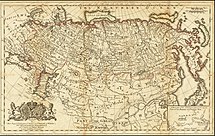Russian Republic
Russian Republic Российская Республика Rossiyskaya Respublika | |||||||||||
|---|---|---|---|---|---|---|---|---|---|---|---|
| 1917–1917 | |||||||||||
| Anthem: Rabochaya Marselyeza The Worker's Marseillaise | |||||||||||
 The Russian Provisional Government in 1917. With the exception of some western areas lost to the German Empire, its territory was essentially the same as that of the preceding Russian Empire after the sale of Alaska to the United States in 1867. | |||||||||||
| Capital | Petrograd | ||||||||||
| Common languages | Russian | ||||||||||
| Government | Provisional government | ||||||||||
| Minister-Chairman | |||||||||||
| Legislature | Council of the Russian Republic | ||||||||||
| Historical era | World War I | ||||||||||
• Proclamation of the Republic | 14 September N.S. 1917 | ||||||||||
| 7 November 1917 | |||||||||||
| Currency | Ruble | ||||||||||
| ISO 3166 code | RU | ||||||||||
| |||||||||||
| Today part of | |||||||||||
| History of Russia |
|---|
 |
|
|
The Russian Republic (also known as Russia) (Russian: Российская республика, tr. Rossiyskaya respublika, IPA: [rɐˈsʲijskəjə rʲɪsˈpublʲɪkə]) was a short-lived state that controlled, de jure, the territory of the former Russian Empire between its proclamation by the Russian Provisional Government on 1 September [14 September, N.S.] in a decree signed by Kerensky as Minister-President and Zarudny as Minister of Justice.[1]
Less than six weeks later, the Republic was overtaken by the October Revolution beginning on 25 October 1917 [7 November, N.S.] and the establishment of the Russian Soviet Federative Socialist Republic (Russian SFSR).[2]
Officially, the Republic's government was the Provisional Government, although de facto control of the country and its armed forces was divided between the Provisional Government and the Petrograd Soviet.
The term Russian Republic is sometimes used erroneously for the period between the abdication of the Emperor Nicholas II on 2 March 1917 [15 March, N.S] and the declaration of the Republic in September. However, during that period the future status of the monarchy remained to be resolved.
Principal institutions
- State Duma of the Russian Empire
- Council of the Russian Republic
- Congress of Soviets
- Russian Provisional Government
- Directorate (Russia)
Regional Autonomies
 Special Transcaucasian Committee
Special Transcaucasian Committee Ukrainian People's Republic
Ukrainian People's Republic Moldavian Democratic Republic
Moldavian Democratic Republic Autonomous Governorate of Estonia
Autonomous Governorate of Estonia Grand Duchy of Finland
Grand Duchy of Finland
Occupied territories
Protectorates
Independence
See also
- Russian Empire
- Russian Civil War
- Russian Democratic Federative Republic
- Russian Soviet Federative Socialist Republic
- Soviet Union
- Petrograd Soviet
- World War I
References
- ^ The Russian Republic Proclaimed at prlib.ru, accessed 12 June 2017
- ^ "Russia". World Statesmen. Retrieved 23 March 2012.
External links
- The Russian Republic proclaimed. Presidential Library
- Browder, R. P., Kerensky, A. F. The Russian Provisional Government, 1917: Documents. "Stanford University Press". Stanford, 1961. ISBN 9780804700238


